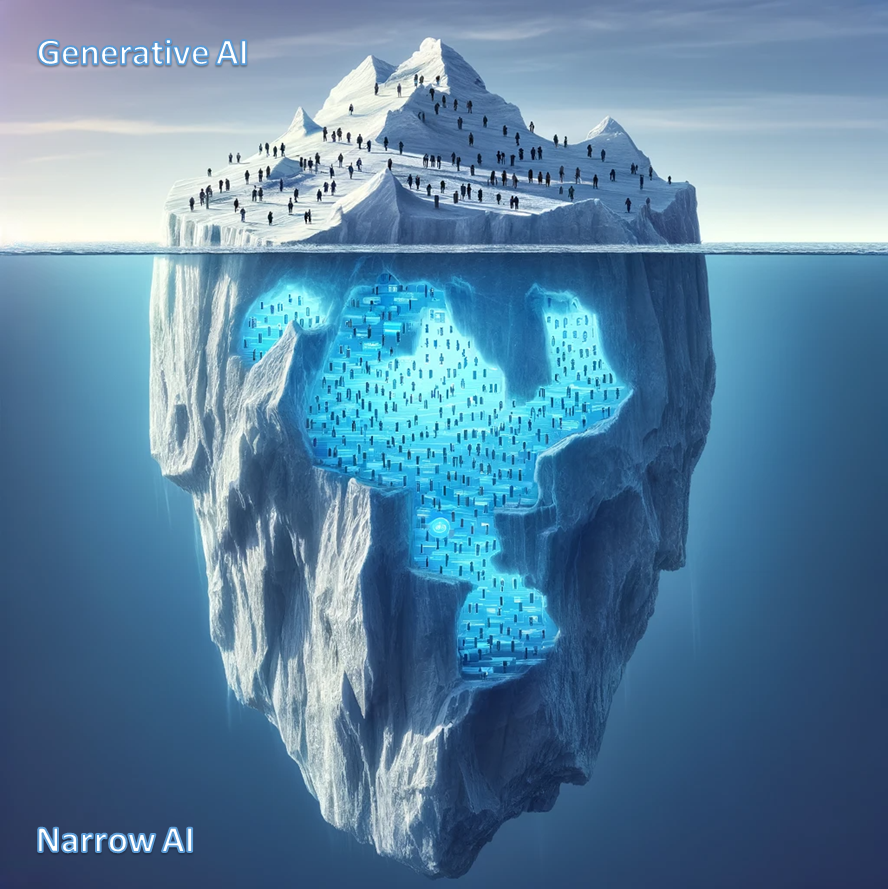

A.I. flavours
Since the success of ChatGPT, we would almost think that Generative A.I. equals A.I. in general. Nothing could be further from the truth. There is an important difference between Generative AI and Narrow AI (also known as Weak AI). Time for a brief clarification then, we think at The House of Coaching.
Narrow AI (Weak AI)
Narrow AI refers to AI systems designed and trained to perform a specific task. These systems are "narrow" or "weak" because their intelligence and learning capabilities are limited to the specific domain for which they are programmed. They cannot operate outside that framework or learn new tasks without additional programming or training.
- Examples: Chatbots designed for customer service, facial recognition systems, and recommendation systems like those used by Netflix or Amazon. There are numerous other applications that we use almost daily without realising that there is "Narrow A.I." behind it. think of :
- Speech Recognition in Smartphones: Systems such as Siri on iPhones, Google Assistant on Android devices, and Bixby on Samsung smartphones. These AIs can understand speech and respond based on pre-programmed commands.
- Recommendation systems: Used by online platforms such as Netflix, Spotify, and Amazon to recommend products, movies, or music based on your previous preferences and behaviour.
- E-mail Spam Filters: AI in email services such as Gmail or Outlook that automatically filters spam and unwanted emails based on certain characteristics.
- Chatbots for Customer Service: Many companies use chatbots on their websites or in customer service apps to answer customer questions and provide support.
- Face recognition: Applied in smartphones for unlocking or by social media platforms such as Facebook for tagging photos.
- Narrow AI in Navigation apps: Such as Google Maps and Waze, which analyse traffic patterns and suggest the fastest route to your destination.
- Banking and Fraud Detection: AI systems used by banks to spot unusual activity on your account and detect potentially fraudulent transactions.
- Smart Assistants in Home Appliances: For example, in smart thermostats like Nest, which learn from your preferences and automatically adjust the temperature in your home.
- Automatic Translation Services: Such as Google Translate, which translates texts between different languages.
- Automatic Content Moderation: Used by social media platforms such as Instagram and YouTube to scan and filter content for inappropriate or harmful content.
- Medical Imaging : AI comparing ideal X-ray images with those of patients, supporting doctors in their decision-making.
- Characteristics of Narrow AI are:
- Specialisation: The AI is trained for a very specific purpose, e.g. analysing medical images.
- Based on Training Data: The AI's ability to be deployed depends on the quality and diversity of the training data it has been trained on.
- No General Intelligence: These systems cannot function outside their training. For example, they cannot be used for other types of tasks without additional training.
- Supporting Decision Making: In e.g. medical imaging, Narrow AI systems are often used as support tools to help doctors make decisions, but they do not usually replace a specialist doctor's clinical assessment.
Generative AI
Generative AI, on the other hand, refers to AI systems that can generate new content similar to human-generated content. This can include text, images, music, speech or even code. Generative AI models learn from a large dataset of existing content and use this knowledge to create new, original content.
- Examples: GPT-3 or GPT-4 (for text generation), DALL-E (for image creation), and AI composers that can generate new pieces of music.
- Features:
- Can be creative and generate new content that is not explicit in the training data.
- Flexible in application across domains.
- Has the ability to learn and adapt to new information or guidelines.
As is common with Narrow AI, with generative AI we will also have to remember that it is supportive and that human intelligence still remains appropriate for evaluation and use of the end result.
In essence, the biggest difference between the two is scope and flexibility. Narrow AI is highly specialised and limited to specific tasks, while generative AI has a wider range of capabilities and is capable of producing new, original output comparable to human creativity.
